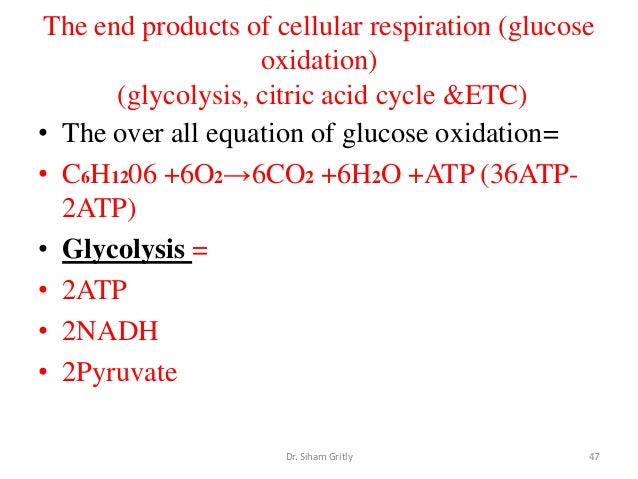550 Catabolite and End Product Repression of Krebs Cycle Enzymes Eur. Pyruvate and it condenses with 4 carbon oxaloacetate which is generated back in the Krebs cycle.
 Krebs Cycle Citric Acid Cycle Tca Cycle With Steps And Diagram
Krebs Cycle Citric Acid Cycle Tca Cycle With Steps And Diagram
It captures the energy stored in the chemical bonds of acetyl-CoA from the products.

End product of krebs cycle. Because two acetyl-CoA molecules are produced from each glucose molecule two cycles are required per glucose molecule. 2 NADHs See The Preparatory Stage for more information -Krebs Cycle two times. The end product of Krebs cycle is an inorganic carbon substance.
Krebs cycle occurs in the mitochondrial matrix. In bacteria addition of the amino acid products of the Krebs cycle to the growth medium causes repression. These enter or exit the cycle at various points depending on demand.
At the end of the Krebs cycle the final product is oxaloacetic acid. Three molecules of NADH. The end products of the Krebs cycle for every two molecules of pyruvic acid include 2 ATP molecules 10 NADH molecules and two FADH2 molecules as well as six CO2 molecules in the form of waste gas.
2 ATPs and 2 NADHs See Glycolysis for more information -Pyruvate Oxidation two times. Carbon dioxide is released during the process of Krebs cycle. For each acetyl-CoA molecule the products of the citric acid cycle are two carbon dioxide molecules three NADH molecules one FADH 2 molecule and one GTPATP molecule.
The levels of Krebs cycle enzymes were measured in wild type after growth on sucrose and acetate media with and without 050 casamino acids. The citric acid cycle takes place in the matrix of the mitochondria. See Krebs Cycle for more information -6 NADHs.
Two GTP six NADH. The end product of glycolysis is pyruvic acid whereas acetyl CoA is the connecting link between glycolysis and Krebs cycle. These are produced as a result of oxidation of the end product of glycolysis pyruvate.
One molecule of GTP. The Krebs cycle also known as the citric acid cycle or tricarboxylic acid cycle TCA cycle is the second step of the aerobic respiration in living organisms. Now the molecule is ready to accept another acetyl-CoA molecule to begin another turn of the cycle.
The citric acid cycle begins with the fusion of acetyl-CoA and oxaloacetate to form citric acid. For example alpha-ketoglutarate can leave the cycle to be converted into amino acids and succinate can be converted to haem. No carbon dioxide is released during the process of glycolysis.
Products of the first turn of the cycle are one GTP or ATP three NADH one QH 2 and two CO 2. This is identical to the oxaloacetic acid that begins the cycle. The cycle takes place in a mitochondrial matrix producing a chemical energy in the form of NADH ATP FADH₂.
The cycle which starts with the 3- carbon molecule called pyruvic acid breaks it down into acetyl coenzyme A which then further combines with oxalo acetic acid to form citric acid. Pyruvate is produced in the glycolysis which is the first step of cellular respiration. The citric acid cycle or the Krebs cycle is one of the steps in cellular respiration and consists of a series of reactions that produces two carbon dioxide molecules one GTPATP and reduced forms of NADH and FADH2.
The Krebs cycle also known as the citric acid cycle or TCA cycle is a series of reactions that take place in the mitochondria resulting in oxidation of acetyl CoA to release carbon dioxide and hydrogen atoms that later lead to the formation of water. Each of the two acetyl-CoA molecules goes once through the citric acid cycle. The Products of the Krebs Cycle.
Acetyl CoA which is produced from the end product of glycolysis ie. In all eukaryotes mitochondria is the site where Krebs cycle takes place. Therefore at the end of two cycles the products are.
Acetyl CoA combines with oxalo acetic acid to form citric acid. In respect to this what are the end products of the Krebs cycle. The Krebs cycle which takes place in the mitochondria of the cell helps in generating energy and occurs immediately after glycolysis.
During the Krebs cycle pyruvate is completely oxidized into carbon dioxide and water. In summary the Krebs Cycle is a biochemical pathway that breaks down Acetyl CO A producing CO2 hydrogen atoms and ATP. The TCA cycle was first described by Krebs 1937 as a cyclic process in which acetyl coA is oxidised to CO 2 and water.
The Krebs Cycle also known as the Citric Acid Cycle is the process discovered by Hans Krebs a German biochemist. This process works as the engine of Cellular Respiration. One molecule of FADH₂.
End products and results. Krebs cycle is the second step of the cellular respiration. Glycolysis is the first step of the cellular respiration.
Each citric acid cycle forms the following products. End product of citric acidKrebs cycle is. The Krebs cycle happens in the mitochondria of a cell and its an important part in generating energy or ATP molecules.
Two molecules of carbon dioxide.
Popular Posts
-
This is a list of the 100 most populous counties in the United States based on the national decennial US census conducted on April 1 2010 an...
-
Population identify as Native American or Alaska Native with 44 identifying as at least one other race according to 2010 Census Bureau data ...
-
He ruled from 5 April 1462 to 27 October 1505 he was known as Ivan the Great and was a Grand Prince of Moscow. 29 October 1603 Moscow Russia...
Featured Post
eyes but cannot see verse
83 Bible Verses about Have Eyes But Do Not See . “Son of man, you dwell in the midst of a rebellious house, who have eyes to see, but ...

ads
